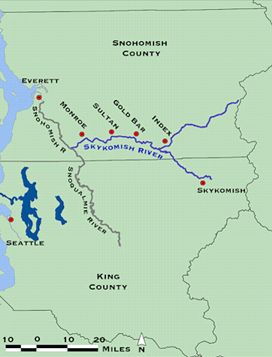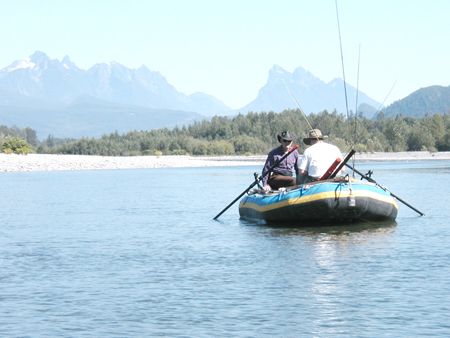|
||||
|
|
|
|||
| Home | Subscribe | Back Issues | The Organization | Volunteer | ||||
|
||||
Skykomish One of Nation's Top-Ten Endangered RiversRiver is "being loved to death"The environmental organization American Rivers recently named the Skykomish river--in Washington's Snohomish and King counties--one of the top ten endangered rivers in the United States. Below is the report from that organization. 
Runaway development threatens to foul the clear waters of the Skykomish River, known for its fishing and other outdoor activities, working farms, forests, and rural quality of life. Unless the Snohomish County Council plans responsibly for growth and acts to protect the river, the very characteristics that make the valley so attractive to its residents could be lost. The RiverThe Skykomish River begins as a series of small streams trickling off snowy mountain peaks in the Mount Baker-Snoqualmie National Forest, northeast of Seattle. As the river flows west, it leaves forested slopes and moves through a landscape of family farms. The river's north and south forks meet near the town of Index, and where the Skykomish joins the Snoqualmie River they form the Snohomish River, which flows into Puget Sound at the city of Everett. The Skykomish was the first river designated in Washington's Scenic Rivers Program. Local residents cherish the river and enjoy opportunities for salmon and steelhead fishing, whitewater boating, and other family outings. The "Sky" lures families from across the state to enjoy these activities, as well.
The ThreatThe Skykomish River valley is at grave risk of being loved to death. The population of Snohomish County, one of the fastest growing in the state, has increased by 30 percent since 1990 and is expected to expand by a third again by 2020. Without a strong plan to manage growth, runaway development will damage the health of the river and diminish the quality of life for watershed residents. Poorly planned development devours forested shorelines and working farms. This is a nationwide problem because conventional construction practices for big box stores, strip malls, and parking lots smother habitat and lead to massive increases in polluted stormwater running into local streams and rivers. Stormwater carries high loads of pesticides, fertilizers, metals, automotive chemicals,chemicals, trash, and other pollution. In the worst case, stormwater can cause sewer systems to leak or overflow, filling rivers and streams with disease-causing germs. Concrete and other impervious surfaces prevent rain from recharging groundwater, causing lower river flows and leading to even greater pollution. Lower water quality is a big reason why wild steelhead and salmon numbers on the Skykomish aren't what they used to be. There was a time when the river's renowned winter steelhead fishery lasted through winter until April. In recent years, low returns forced the state to close the fishery in February. Without protections for the river, fish numbers will continue to decline. Implementing protections now would be more cost-effective than paying for expensive restoration measures in the years to come. As part of a locally-driven salmon recovery process, a diverse group of Snohomish County farmers, developers, local governments, tribes, and others have drafted a plan to protect and restore the Skykomish River. The draft plan reveals that without suitable land protections, salmon and steelhead will continue to decline. What's at StakeThe Skykomish's clear, clean water and the salmon, steelhead, and char that swim in it are in danger. Farmers and other residents have set an example for neighboring counties with their efforts to restore salmon runs, but this investment will be lost if runaway growth transforms the valley. The quality of life for everyone who lives in the Skykomish River valley is also at stake. One local city chamber of commerce touts the scenery and excellent fishing on the Skykomish as reasons to move to the area, but out-of-control development jeopardizes those very qualities. Congested, dangerous roads can be a major problem without thoughtful landuse planning. Family farms and rural areas would be harmed or eliminated by gridlock and sprawl, and increased air and water pollution would threaten the safety and health of county residents. The 12-Month OutlookSnohomish County is drawing up two blueprints for the future that provide current residents with their best chance for protecting their property and lifestyle, while preserving clean water, salmon and wildlife, for generations to come. The county is revising its Comprehensive Plan, its broad vision for growth and development. To protect the Skykomish River and quality of life, the county should direct new development to existing urbanized areas. The County Council should protect natural areas, expand public transit, establish parks, and link residential and commercial areas with hiking, biking and walking trails. These steps will reduce the amount of stormwater that pollutes the Skykomish River and protect groundwater supplies. The Snohomish County Council should also reject proposals for new "Fully Contained Communities," new cities that would likely replace forests with pavement and pollution. The county will release the plan and accompanying studies in May and June 2005. After a series of public hearings, the County Council will make its decision on the Comprehensive Plan before the end of summer. At the same time, the county is updating its Critical Areas Ordinance, which governs development in environmentally sensitive areas like wetlands and stream corridors. To safeguard the Skykomish and protect property, the Snohomish County Council should adopt measures protecting the main channel and tributary streams with science-based buffers, stronger stormwater controls, and low impact development methods that limit impervious surfaces and enhance native vegetation. The county will release the update and a study of its environmental implications for public comment in spring or summer 2005. Contact Amy Souers Kober, American Rivers, (206) 213-0330 ext. 23, akober@americanrivers.org ; JOHN MAURO, Pilchuck Audubon Society, (425) 252-1927, john@pilchuckaudubon.org ; RICH SIMMS, Wild Steelhead Coalition, (425) 941-7041, wscmembership@yahoo.com |
|

